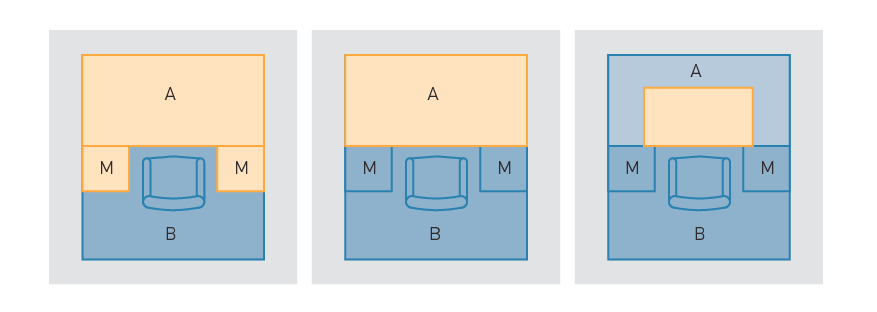The VDU workstation consists of a workstation with at least one screen device and other possible work equipment (e.g. data output devices, external storage devices, phone, fax and other equipment such as documents, work desk, work surface, work chair, manuscript holder) as well as the working area immediately surrounding the workstation (surrounding area).
Terms and definitions
An individual VDU workstation is a VDU workstation located in a work room not primarily intended for screen work, e.g. for data entry or data retrieval in banking halls, manufacturing or storage areas.
The visual task area is the partial area at the workstation were the visual task is carried out. For the visual task area, the photometric lighting requirements according to EN 12464-1 apply. Its size, however, is not defined.
The working area in office rooms is the space where the visual task is carried out at different points. In rooms with one or more VDU workstations, there are generally several different working areas (see figure).
Screen working area. The screen working area comprises the areas of the following visual tasks: Screen work, information intake from the screen, using the input devices, usual writing and reading tasks, visual communication, information intake and the use of further work equipment such as phone, printer etc. The screen working area is composed of all surfaces where visual tasks are performed. These surfaces can be horizontal, tilted or vertical. Furthermore, surfaces where the work equipment directly serving the work progress is located (work surfaces) as well as surfaces which are required for proper and professional execution of screen work (user areas).
In the working area "screen work", the following surfaces, among others, can feature visual tasks:
the desk surface (work surface A) and the functional furniture area M, e.g. including the opened drawers or a hanging file frame with additional visual tasks (fig.)
only the desk surface (work surface) (fig.) oder
only a partial area on the desk surface (fig.)
The focal point of the visual tasks for the work task at hand or in the working area in question as well as which lighting concept is best suited for it must be coordinated among designer and user.
Meeting working area. The meeting working area comprises e.g. the areas of the following visual tasks: Meeting, visual communication, information intake from meeting documents, usual writing and reading tasks, possible information intake and input at notebooks or other devices. The meeting working area in the office space is therefore comprised of table surface (working area) and user area.
Working area - reading work at cabinets and shelf units.The working area - reading work at cabinets and shelf units comprises the following visual tasks: Recognising labels and short periods of reading. The visual task areas on cabinets and shelf units range from 0,5 m to 2,0 m above the floor.
Work surfaces at individually assigned workstations in the office are identical to the desk surface, and in desk combinations also include connecting elements and side cabinets (figure).
Functional furniture areas are areas needed to fully open cabinets or drawers without trouble or hindrance.
User areas are areas required for proper and professional execution of the work which facilitate natural human motion sequences and provide sufficient room for changes in posture (sitting and standing up).
Surrounding areas according to EN 12464-1 are areas immediately surrounding the visual task area at a minimum width of 0,5 m. For offices, the surrounding area should be dimensioned larger according to purpose. It is the space directly adjacent to one or more working areas which ranges up to 0,5 m from each room wall unless other workstations are located there. The surrounding area can be illuminated at one level lower than the working area, meaning 300 lx in offices according to EN 12464-1.
The horizontal assessment planes for illuminance levels of the visual task area as well as the surrounding area are located 0,75 m above the floor, corresponding to the location of most visual tasks. This dimension is due to the very commonly found desk height of 0,72 m and the usual height of measuring instruments of 0,03 m (see chapter "Lighting measurement").

Figure 3.93: Possible surfaces with visual tasks at office workstations and recommended lighting concepts, A = work surface, M = functional furniture area, B = user area